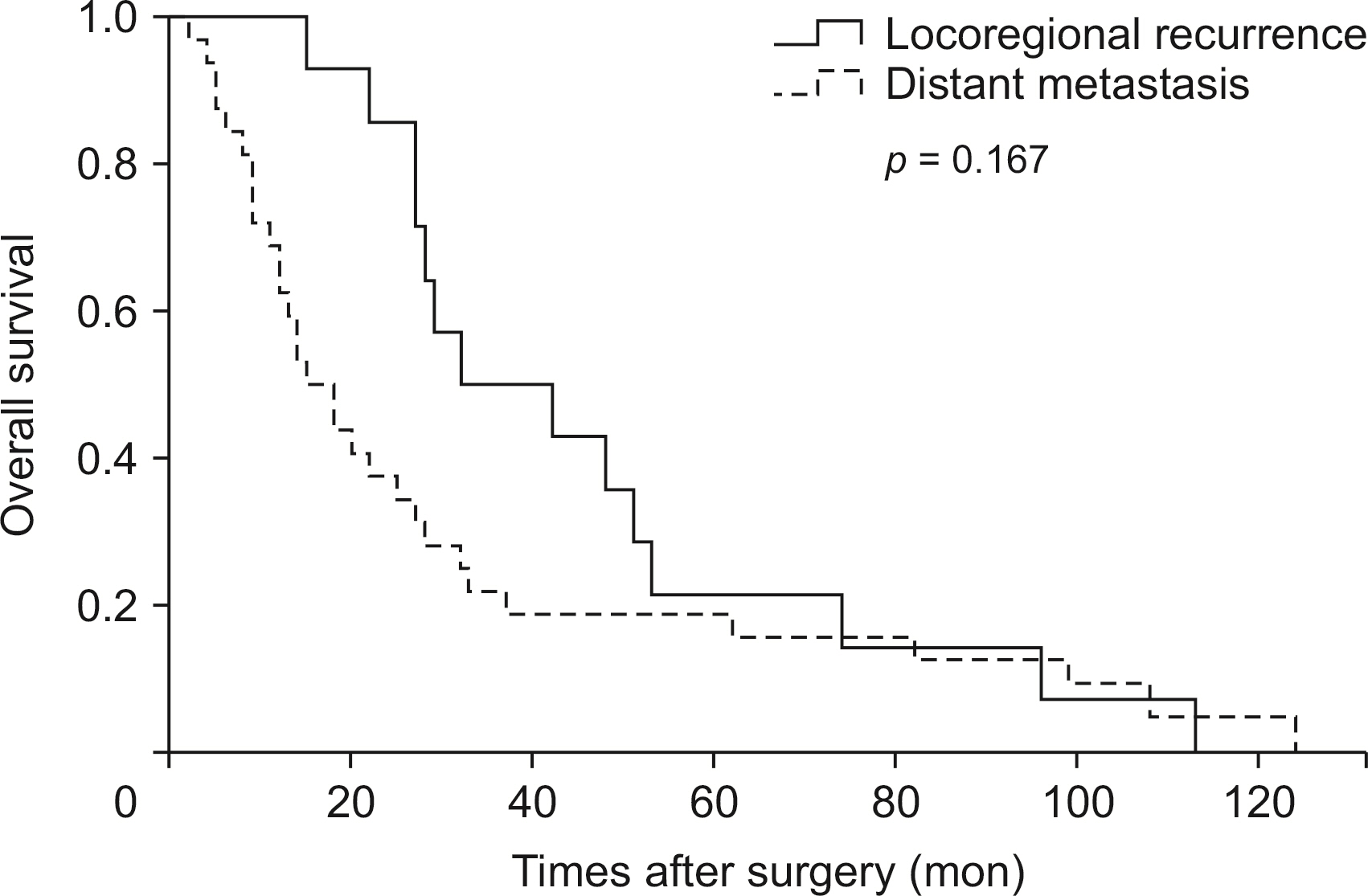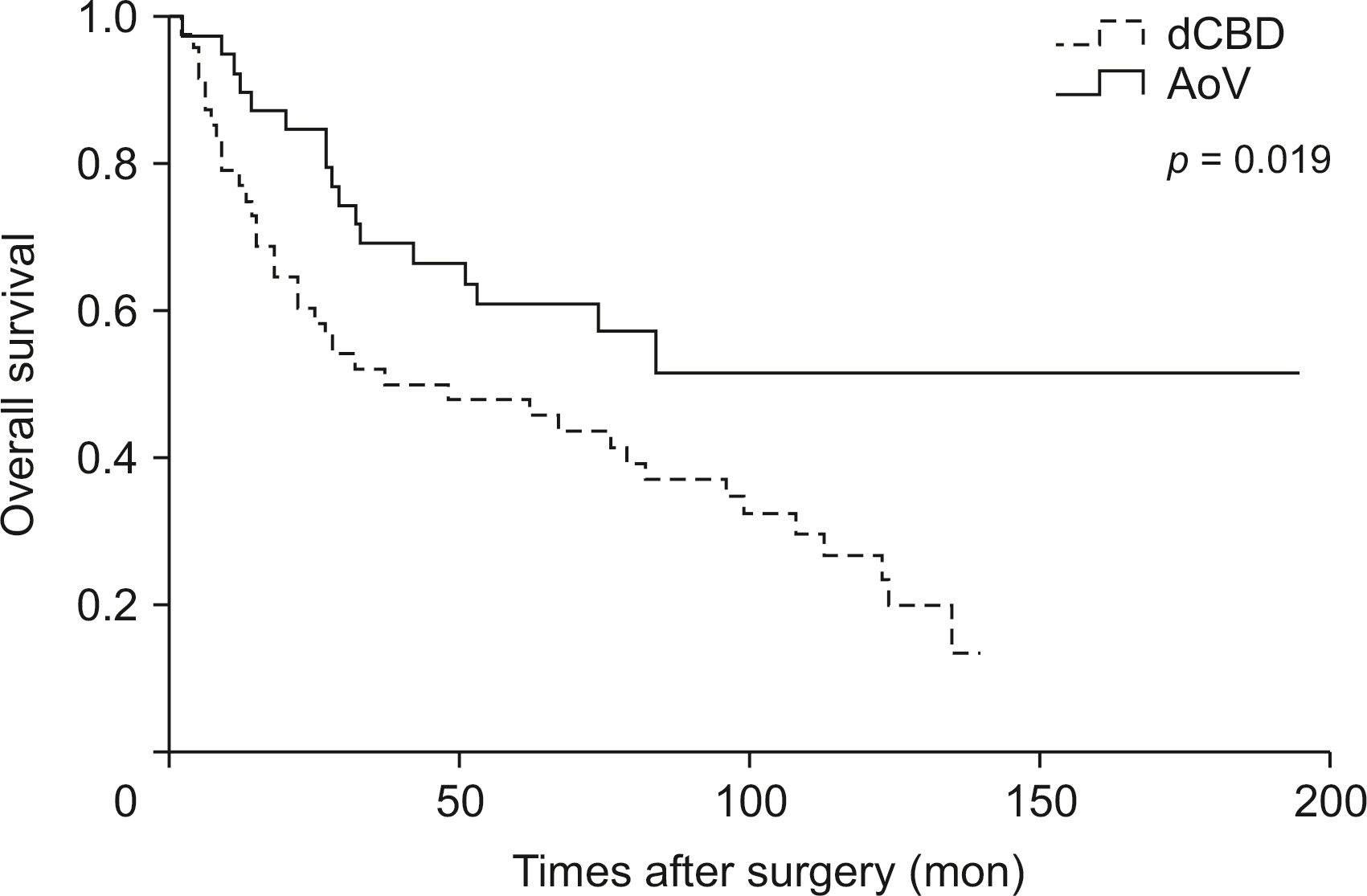Ann Hepatobiliary Pancreat Surg.
2022 May;26(2):138-143. 10.14701/ahbps.21-129.
Factors influencing patterns of recurrence following pancreaticoduodenectomy for patients with distal bile duct cancer and ampulla of Vater cancer
- Affiliations
-
- 1Department of Surgery, Yeungnam University College of Medicine, Daegu, Korea
- KMID: 2530092
- DOI: http://doi.org/10.14701/ahbps.21-129
Abstract
- Backgrounds/Aims
Pancreaticoduodenectomy (PD) is a standard surgical procedure for patients with periampullary cancer. During the follow-up period after PD, recurrence can be observed in various places with different prognosis. The aim of this study was to clarify the pattern of recurrence and factors affecting the survival of patients with periampullary cancer.
Methods
Overall, 88 patients who received PD for distal common bile duct cancer or ampulla of Vater cancer were finally included and their clinical characteristics were analyzed. Patients were divided into three groups: recurrence-free (RF) group, an isolated locoregional recurrence (LR) group, and a distant metastasis (DM) group. Prognostic factors affecting recurrence in each group were analyzed and a survival analysis was performed.
Results
Perineural invasion (PNI), T stage, and lymphovascular invasion (LVI) were significant risk factors for LR and PNI, lymph node metastasis, LVI, and T stage were associated with DM group compared to RF group in univariate analysis, respectively. N stage and PNI were significant risk factors (p = 0.046, p = 0.041) in overall survival of the LR and the DM groups. There was no significant difference in 5-year overall survival between the LR and DM groups.
Conclusions
T stage was a significant risk factor of LR, while PNI was a significant risk factor of DM. There was no significant difference in overall survival depending on the site of recurrence.
Figure
Reference
-
1. Park JS, Yoon DS, Kim KS, Choi JS, Lee WJ, Chi HS, et al. 2007; Factors influencing recurrence after curative resection for ampulla of Vater carcinoma. J Surg Oncol. 95:286–290. DOI: 10.1002/jso.20665. PMID: 17326125.
Article2. Komaya K, Ebata T, Shirai K, Ohira S, Morofuji N, Akutagawa A, et al. 2017; Recurrence after resection with curative intent for distal cholangiocarcinoma. Br J Surg. 104:426–433. DOI: 10.1002/bjs.10452. PMID: 28138968.
Article3. Choi SB, Park SW, Kim KS, Choi JS, Lee WJ. 2009; The survival outcome and prognostic factors for middle and distal bile duct cancer following surgical resection. J Surg Oncol. 99:335–342. DOI: 10.1002/jso.21238. PMID: 19226533.
Article4. Woo SM, Ryu JK, Lee SH, Yoo JW, Park JK, Kim YT, et al. 2007; Recurrence and prognostic factors of ampullary carcinoma after radical resection: comparison with distal extrahepatic cholangiocarcinoma. Ann Surg Oncol. 14:3195–3201. DOI: 10.1245/s10434-007-9537-y. PMID: 17710498.
Article5. Kim H, Kwon W, Kim JR, Byun Y, Jang JY, Kim SW. 2019; Recurrence patterns after pancreaticoduodenectomy for ampullary cancer. J Hepatobiliary Pancreat Sci. 26:179–186. DOI: 10.1002/jhbp.618. PMID: 30849209.
Article6. Courtin-Tanguy L, Rayar M, Bergeat D, Merdrignac A, Harnoy Y, Boudjema K, et al. 2016; The true prognosis of resected distal cholangiocarcinoma. J Surg Oncol. 113:575–580. DOI: 10.1002/jso.24165. PMID: 26776934.
Article7. El Nakeeb A, El Sorogy M, Ezzat H, Said R, El Dosoky M, Abd El Gawad M, et al. 2018; Predictors of long-term survival after pancreaticoduodenectomy for peri-ampullary adenocarcinoma: a retrospective study of 5-year survivors. Hepatobiliary Pancreat Dis Int. 17:443–449. DOI: 10.1016/j.hbpd.2018.08.004. PMID: 30126828.
Article8. Yeo CJ, Sohn TA, Cameron JL, Hruban RH, Lillemoe KD, Pitt HA. 1998; Periampullary adenocarcinoma: analysis of 5-year survivors. Ann Surg. 227:821–831. DOI: 10.1097/00000658-199806000-00005. PMID: 9637545. PMCID: PMC1191384.9. Howe JR, Klimstra DS, Moccia RD, Conlon KC, Brennan MF. 1998; Factors predictive of survival in ampullary carcinoma. Ann Surg. 228:87–94. DOI: 10.1097/00000658-199807000-00013. PMID: 9671071. PMCID: PMC1191432.
Article10. Tol JA, Gouma DJ, Bassi C, Dervenis C, Montorsi M, Adham M, et al. 2014; Definition of a standard lymphadenectomy in surgery for pancreatic ductal adenocarcinoma: a consensus statement by the International Study Group on Pancreatic Surgery (ISGPS). Surgery. 156:591–600. DOI: 10.1016/j.surg.2014.06.016. PMID: 25061003.
Article11. Lee JH, Whittington R, Williams NN, Berry MF, Vaughn DJ, Haller DG, et al. 2000; Outcome of pancreaticoduodenectomy and impact of adjuvant therapy for ampullary carcinomas. Int J Radiat Oncol Biol Phys. 47:945–953. DOI: 10.1016/S0360-3016(00)00537-X. PMID: 10863064.
Article12. Kim RD, Kundhal PS, McGilvray ID, Cattral MS, Taylor B, Langer B, et al. 2006; Predictors of failure after pancreaticoduodenectomy for ampullary carcinoma. J Am Coll Surg. 202:112–119. DOI: 10.1016/j.jamcollsurg.2005.08.002. PMID: 16377504.
Article13. de Castro SM, Kuhlmann KF, van Heek NT, Busch OR, Offerhaus GJ, van Gulik TM, et al. 2004; Recurrent disease after microscopically radical (R0) resection of periampullary adenocarcinoma in patients without adjuvant therapy. J Gastrointest Surg. 8:775–784. discussion 784DOI: 10.1016/j.gassur.2004.08.006. PMID: 15531230.
Article14. van der Gaag NA, ten Kate FJ, Lagarde SM, Busch OR, van Gulik TM, Gouma DJ. 2008; Prognostic significance of extracapsular lymph node involvement in patients with adenocarcinoma of the ampulla of Vater. Br J Surg. 95:735–743. DOI: 10.1002/bjs.6076. PMID: 18300268.
Article15. Bhandare MS, Mondal A, Chaudhari V, Bal M, Yadav S, Ramaswamy A, et al. 2021; Factors influencing local and distant recurrence following resection of periampullary cancer. Br J Surg. 108:427–434. DOI: 10.1093/bjs/znaa143. PMID: 33723577.
Article16. Kayahara M, Nagakawa T, Ohta T, Kitagawa H, Miyazaki I. 1997; Surgical strategy for carcinoma of the papilla of Vater on the basis of lymphatic spread and mode of recurrence. Surgery. 121:611–617. DOI: 10.1016/S0039-6060(97)90048-9. PMID: 9186460.
Article17. Lee JH, Lee KG, Ha TK, Jun YJ, Paik SS, Park HK, et al. 2011; Pattern analysis of lymph node metastasis and the prognostic importance of number of metastatic nodes in ampullary adenocarcinoma. Am Surg. 77:322–329. DOI: 10.1177/000313481107700322. PMID: 21375845.
Article18. Edge SB, Byrd DR, Carducci MA, Compton CC, Fritz A, Greene F. 2010. AJCC cancer staging manual. 7th ed. Springer;New York: DOI: 10.1177/000313481107700322.
- Full Text Links
- Actions
-
Cited
- CITED
-
- Close
- Share
- Similar articles
-
- Ampulla of Vater Cancer in a Patient with Double Common Bile Duct
- Collision tumor of the ampulla of Vater - Coexistence of neuroendocrine carcinoma and adenocarcinoma: report of a case
- A Case of Heterotopic Pancreas in the Ampulla of Vater that Mimicked Distal Common Bile Duct Cancer
- Pancreaticoduodenectomy for secondary periampullary cancer following extrahepatic bile duct cancer resection
- Computed Tomographic Findings of the Carcinoma of the Ampulla of Vater



